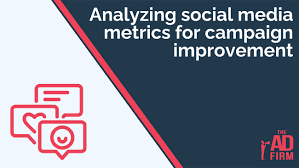Social media metrics provide valuable insights into the performance of your campaigns and help you make informed decisions for future strategies. Knowing how to interpret social media metrics for better campaigns can improve your reach, engagement, and overall results. For more updates on effective strategies, visit http://newztalkies.com. This guide breaks down key metrics, tools, and strategies to optimize your social media efforts effectively.
1. Understanding the Importance of Social Media Metrics
Social media metrics are data points that track the success of your campaigns. They provide a clear picture of what works and what doesn’t, helping you refine your strategies for better results.
Why Metrics Matter
Metrics help you evaluate audience behavior, content effectiveness, and return on investment (ROI). Without analyzing these, campaigns can become guesswork, leading to wasted resources.
Align Metrics with Goals
Every campaign has unique goals. Whether it’s brand awareness, lead generation, or sales, understanding which metrics align with your objectives ensures focused and measurable efforts.
2. Key Social Media Metrics to Track
Tracking the right metrics is essential to gauge the success of your campaigns. Here are the most critical ones:
Engagement Metrics
These include likes, comments, shares, and clicks. High engagement indicates that your content resonates with your audience.
Reach and Impressions
- Reach measures how many unique users see your content.
- Impressions indicate how often your content appears, even if seen multiple times by the same user.
Follower Growth
Monitoring follower trends helps you understand your audience’s interest in your brand. A steady increase shows effective content and campaign strategies.
READ MORE : Tiktok Tips For Creating Better Content
Click-Through Rate (CTR)
CTR measures the percentage of users who click on your links. It’s an important metric for campaigns focused on driving traffic to websites or landing pages.
Conversion Rate
This measures the percentage of users who complete desired actions, like purchasing a product or signing up for a newsletter.
3. Tools to Analyze Social Media Metrics
Various tools simplify the process of tracking and interpreting social media metrics. These tools help gather data, generate reports, and provide actionable insights.
Native Analytics Platforms
- Facebook Insights, Instagram Insights, and LinkedIn Analytics are excellent for tracking platform-specific metrics.
- They provide data on engagement, reach, and audience demographics.
Third-Party Tools
Platforms like Hootsuite, Buffer, and Sprout Social offer advanced analytics features. They allow you to compare metrics across multiple platforms and schedule content.
Google Analytics
This tool helps track website traffic generated from social media campaigns. It’s crucial for analyzing the ROI of campaigns aimed at driving traffic to external sites.
4. Interpreting Metrics for Campaign Optimization
To improve campaigns, you need to go beyond collecting data and focus on interpreting it meaningfully.
Identify Patterns
Look for trends over time to understand audience behavior. For example, noticing a spike in engagement during certain hours can guide future posting schedules.
Compare Metrics
Evaluate how different metrics interact. For instance, if your reach is high but engagement is low, your content might not be compelling enough.
Test and Adjust
Use metrics to run A/B tests. Experiment with headlines, images, or posting times, and analyze which variations yield better results.
5. Using Metrics to Improve Targeting
Metrics are valuable for refining audience targeting, ensuring your campaigns reach the right people.
Analyze Audience Demographics
Use metrics like age, gender, and location to understand who interacts with your content. Tailor campaigns to appeal to these groups.
Understand Behavioral Insights
Metrics like dwell time and click patterns reveal how users engage with your posts. Use these insights to craft content that keeps them interested.
Create Lookalike Audiences
On platforms like Facebook, metrics allow you to create lookalike audiences based on the behavior of your existing followers, broadening your reach.
6. Avoiding Common Mistakes When Interpreting Metrics
Misinterpreting metrics can lead to ineffective strategies. Here’s how to avoid common pitfalls:
Don’t Focus Solely on Vanity Metrics
Metrics like likes and follower counts may look impressive but don’t always reflect meaningful engagement or conversions.
Avoid Overloading with Data
Tracking too many metrics can lead to confusion. Focus on the ones that align with your campaign goals.
Stay Contextual
Metrics should be interpreted within the context of your campaign. A low CTR might not be bad if your goal is brand awareness rather than direct sales.
7. How to Measure Success Using Social Media Metrics
Success looks different for every campaign. Setting clear goals and using metrics to measure them ensures your efforts lead to tangible results.
Define Key Performance Indicators (KPIs)
Establish specific KPIs based on your objectives. For example:
- Engagement rate for brand awareness campaigns.
- CTR and conversions for traffic-driven campaigns.
Use Benchmarks
Compare your metrics to industry benchmarks or past campaign performance to gauge success accurately.
Regular Reporting
Create regular reports to track progress. This helps identify trends and areas for improvement.
Conclusion
Knowing how to interpret social media metrics for better campaigns is essential for maximizing your efforts and achieving your goals. By understanding key metrics, leveraging tools, and focusing on actionable insights, you can refine your strategies and deliver impactful campaigns. Whether you aim to boost engagement, increase conversions, or improve targeting, interpreting metrics effectively ensures that your social media campaigns consistently deliver results.



